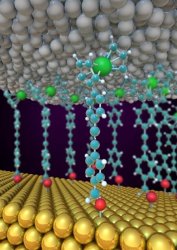Molecular electronics aims to generate devices where the electrical characteristics are determined by the chemical and supramolecular properties of the molecules. To develop functional molecular devices in a rational manner, one must first understand how molecules conduct charges.  The mechanism of charge transport for a given system is still very difficult to predict because it depends on a large number of intertwined factors including molecule—electrode interactions, chemical and supramolecular structure of the junctions, electronic structure, collective electrostatic affects, but also on defects, or the dynamics of junctions. We are particularly interesting in studying the mechanisms of charge transport in details, and to apply his knowledge to develop junctions with new functionalities. We study junctions of the form electrode-SAM-electrode fabricated using the "EGaIn Technique" (SAM = self-assembled monolayer) to develop/improve functional molecular devices based on various types of switches, to improve our understanding of charge transport across biomolecules, and to study light-matter interactions inside junctions.
The mechanism of charge transport for a given system is still very difficult to predict because it depends on a large number of intertwined factors including molecule—electrode interactions, chemical and supramolecular structure of the junctions, electronic structure, collective electrostatic affects, but also on defects, or the dynamics of junctions. We are particularly interesting in studying the mechanisms of charge transport in details, and to apply his knowledge to develop junctions with new functionalities. We study junctions of the form electrode-SAM-electrode fabricated using the "EGaIn Technique" (SAM = self-assembled monolayer) to develop/improve functional molecular devices based on various types of switches, to improve our understanding of charge transport across biomolecules, and to study light-matter interactions inside junctions.
